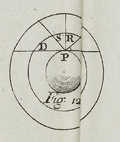
A Treatise on Painting, by Leonardo da Vinci
1721
Senex and Taylor, London
Illustrations:  | Chapter Display  |
I312
By how much the Air approaches nearer the Horizon, by so much it will participate the more of an Azure; and on the contrary, the more remote from the Horizon, the dimmer and more obscure, will its Blue be seen: The Reason of this, I have already given in my Treatise of Perspective, where, I have shewn, that a Body both receives and reflects a less share of Light, in Proportion as the Body is thinner, and less subtil. Now it is confess'd, that the Air far distant from the Earth, is purer and more refined than that in its Neighbourhood; of Consequence therefore, the upper Regions of the Heavens must be darker, and more obscure than the Air below, through which the Sunbeams penetrating, enlighten an infinity of Atoms swimming in it, and thereby render it visible to the Eye: Hence the Species of the abovemention'd dark Regions, passing through those more enlighten'd Ones underneath; the whiteness of the latter, must of Necessity be qualified by the obscurity of the former, and will thereby become Azure: Now this Azure will appear still brighter, as the Quantity of Air interposed between the Eye and the Obscurer Parts is greater; as for instance, suppose the Eye placed at P, [Tab. 1. Fig. 12.] and let it look along the Line P R; then lowering a little, let it look along the Line P S; in this latter Case the Air will appear somewhat brighter than in the former, because, it looks through a greater quantity of Gross Air; but if the Eye look directly toward the Horizon, then the Azure which appeared deep in the first Line, and somewhat fainter in the second, will in a measure wholly disappear in the third, there being a much greater Quantity of gross Air in the Horizontal Line P D, than in the Oblique One P S, or the Perpendicular P R.